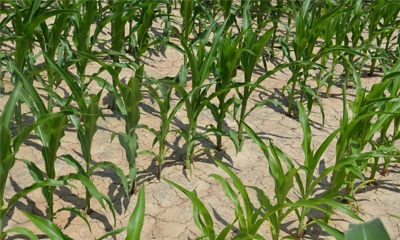
Bob Nielsen seems like a prophet. The Purdue Univeristy Extension soils specialist has been saying for several months now that the only thing we know with certainty about an upcoming season is that it will be extreme. He nailed it again! For many farmers, this spring was again anything but normal. It posed special challenges due to cool, wet weather in many areas. Some of the methods farmers tried to deal with these challenges appeared to work, while others didn’t work so well.

SOIL COMPACTION EXISTS: It’s not hard to find compacted areas in fields after a wet spring, especially if soil was worked while wet. Some say deep-rooted cover crops can help offset soil compaction issues.
Indiana Conservation Partnership personnel, led by a team of Natural Resources Conservation Service professionals, have assembled information relating to this spring and how you might deal with the consequences. The team includes Don Donovan and Clint Harrison, district conservationists; Susannah Hinds, grazing specialist; Scot Haley, resource soil scientist; Kris Vance, public affairs specialist; Victor Shelton, state agronomist/grazing specialist; Tony Bailey, state conservation agronomist; and Shannon Zezula, state resource conservationist.
Soil compaction
When the wet spring extended into late May, did you plant in soils that were wetter than you would have liked? Did you use a vertical-tillage tool or disk to “open up” the soils so they would dry? If so, it may have caused soil compaction. Reports indicate some no-till farmers who tried a vertical-tillage tool to get into the field faster wound up creating soil compaction that slowed crop growth earlier this summer.
If you have soil compaction issues, your first thought may be to run a deep ripper through those fields this fall. Donovan has seen farmers who use cover crops alleviate soil compaction with deep-rooted species such as annual ryegrass, daikon oilseed radish and cereal rye. Not only are they addressing soil compaction, but they are also getting all the other benefits of cover crops, such as soil erosion control, nitrogen scavenging and weed control.
Before you hook to the deep ripper, Donovan suggests considering hooking up the drill and sowing some cover crops this fall.
Herbicide issues
If you do plan to sow cover crops, have you taken into consideration any herbicide carryover impact? Donovan says applications of residual herbicides to control late-emerging broadleaf weeds such as marestail can impact cover crops such as radishes, peas and clovers.
There are several factors that impact the persistence of herbicides in the soil. They include soil pH, soil organic matter, temperature, precipitation totals, exposure to sunlight, soil texture and biological activity. Additionally, understanding the differences in mode of action of each herbicide group is a great predictor of how tolerant a cover crop may be to each class of chemistry.
If it fits your plan, focus your fall broadleaf cover crops on those fields least likely to have residual herbicide issues. Hopefully, those are some of the fields where you would like to try cover crops to mitigate soil compaction.
Check out these links for more information: Penn State weed scientists, Midwest Cover Crops Field Guide and Purdue Extension Weed Science.
About the Author(s)
You May Also Like




